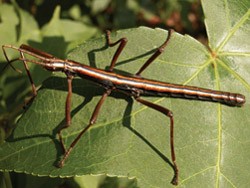 STICK IT TO ‘EM
STICK IT TO ‘EM
Walking stick insects like this one can lash out at predators with noxious chemical sprays emitted from a gland behind the head.
Walking stick study hints at chemical biodiversity in these insects
It’s safe to say that not many people have milked the insects known as walking sticks for the defensive secretions the insects spray when threatened. Now, milkers in Gainesville, Fla., have used nuclear magnetic resonance spectroscopy to discover that the secretions of individual walking sticks are chemically distinct. “Single-insect variability of venom demonstrates the potential variability of chemical biodiversity at the level of individual animals,” the researchers say.
Walking sticks would never have perambulated into Arthur S. Edison’s laboratory at the University of Florida’s McKnight Brain Institute were it not for graduate student Aaron T. Dossey, an amateur entomologist who roams the Florida landscape collecting insects, including walking sticks. Dossey has repeatedly been on the business end of the insects’ chemical weaponry, which is extremely noxious to the nose and eyes.